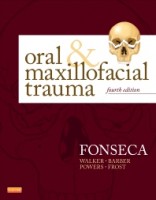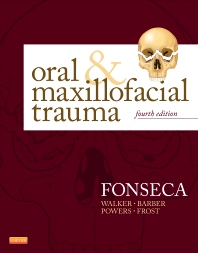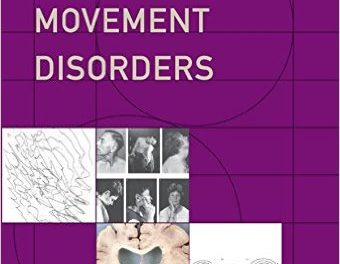 Editors: Raymond J. Fonseca, Robert W. Walker, H. Dexter Barber, Michael P. Powers, and David E. Frost
Editors: Raymond J. Fonseca, Robert W. Walker, H. Dexter Barber, Michael P. Powers, and David E. Frost
Publisher: Elsevier Saunders – 875 pages
Book Review by: Nano Khilnani
Go to https://PageBurststore.Elsevier.com to view Elsevier Digital Books on your desktop or mobile device. PageBurst integrates Elsevier’s trusted content with powerful interactive tools to help you create a more productive, enjoyable learning experience.
• Pageburst offers quick, easy access to the Elsevier content you use and rely on, along with organizational tools to increase your efficiency.
• Pageburst makes it easy to search, take notes, highlight content, and collaborate with classmates and colleagues.
This book provides extensive coverage of the many aspects of oral and maxillofacial trauma with its 34 chapters organized around four Parts. Those four Parts are:
• Principles in the Management of Traumatic Injuries
• Systematic Evaluation of the Traumatized Patient
• Management of Head and Neck Injuries
• Special Considerations in the Management of Traumatic Injuries
This volume is the combined work of 84 specialists who contributed articles to it, as well as the efforts of five editors who put the material into shape for publication. It is a high-quality product made of glossy pages with numerous graphic aids facilitating the understanding of the material therein. The chapters cover a large range of subjects.
In Part I on the management of traumatic injuries, you can study – in three chapters – metabolic response to trauma, and nutrition and wound healing for the oral and maxillofacial surgery patient.
In Part II with six chapters, you learn how to make an initial condition assessment and care intensively for the trauma patient, do emergency airway management, manage non-penetrating chest trauma, recognize and manage shock, do a neurological evaluation, and deal with abdominal trauma in the patient.
In Part III on the management of head and neck injuries, you will find a large range of subjects within its 13 chapters. You learn applied surgical anatomy of the head and neck; do an early assessment and treatment planning of the maxillofacial trauma patient; perform a radiographic evaluation of facial injuries; diagnose and manage dentoalveolar injuries; learn how to deal with mandibular fractures and injuries to the mandibular condyle.
In this Part you also assess and treat fractures of the zygomatic complex and arch; diagnose and treat mid-face fractures; look at and deal with ophthalmic consequences of maxillofacial injuries; evaluate and manage frontal sinus injuries; evaluate and manage nasal fractures; manage soft tissue injuries; heal wounds and scars from soft tissue injuries; manage and treat human and animal bites; diagnose and manage traumatic salivary gland injuries; and deal with injuries to the trigeminal nerve.
In Part IV on special considerations in the management of traumatic injuries, you have nine chapters through which you take into account anesthetic considerations; take care of ballistic and missile injuries; treat head and neck burn injuries; diagnose and manage facial fractures in children; treat oral and maxillofacial trauma in elderly patients; learn to reconstruct avulsive defects of the maxillofacial complex; deal with infections in maxillofacial trauma patients; learn the principles of fixation for maxillofacial trauma, and do minimally invasive oral and maxillofacial trauma surgery.
Each chapter starts with an Outline that lists the topics covered therein. For example in Chapter 1 entitled Metabolic Response to Trauma, the topics listed are: Physiologic Response, Mediators of the Response (listing as subtopics: Neuro-endocrine Response, Lipid-Derived Mediators, Cytokines, and Polymorphonuclear Neutrophils), and Clinical Implications (listing as subtopics: Modulations of the Response, Adult Respiratory Distress Syndrome, Nutrition as Therapy, Deep Vein Thrombosis Prophylaxis, and Stress Gastritis).
Each of these topics and the subtopics under them is taken up in the chapter, with study aids such as: anatomical drawings, charts, illustrations, images seen through microscopes, photos (black-and-white and full-color), tables, and x-rays. Photos of actual injured patients are provided to the student, showing the treatment he or she received, as well as the surgical procedures initiated.
In addition to the various topics discussed in varying lengths and colorful illustrations to better understand them in each chapter, a Summary is provided at the end, as well as a list of References for further study.
This is probably one of the best books out there on the subject of oral and maxillofacial trauma and surgery. The contributors and editors have indeed done a super marvelous job, creating a unique and very useful book. Some information on its editors is provided below.
Raymond J. Fonseca, DMD has a private practice based in Asheville, North Carolina. He is also a Clinical Professor in the Department of Oral and Maxillofacial Surgery at the University of North Carolina in Chapel Hill, North Carolina.
Robert V. Walker, DDS, FACD is Professor Emeritus in the Division of Oral and Maxillofacial Surgery at the University of Texas Southwestern Medical Center in Dallas, Texas. He is also Chairman of the Board of Directors of the American Trauma Society in Upper Marlboro, Maryland.
H. Dexter Barber, DDS is in private practice in Mesa and Laveen, Arizona. He is also an Adjunct Associate Professor at the Department of Oral and Maxillofacial Surgery at Temple University Hospital in Philadelphia, Pennsylvania.
Michael P. Powers, DDS, MS has a private practice in Kent, Ohio, and is affiliated with Robinson Memorial Hospital in Ravenna, Ohio.
David E. Frost, DDS, MS is in private practice in Chapel Hill and Durham in North Carolina. He is also a Clinical Adjunct Assistant Professor at the University of North Carolina in Chapel Hill, North Carolina.







